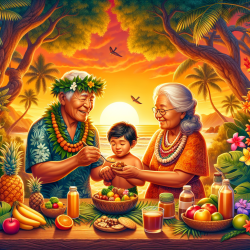Introduction
In the realm of speech-language pathology, understanding cultural influences on feeding practices is pivotal for tailoring interventions that resonate with diverse communities. The study "Native Hawaiian Complementary Feeding Practices as Told by Grandparents: A Transgenerational Experience" sheds light on the evolving nature of traditional Hawaiian feeding practices and their implications for child health outcomes. This blog explores how practitioners can leverage these insights to enhance their therapeutic approaches.
Understanding Traditional Practices
The research highlights that traditional Hawaiian complementary feeding practices have been influenced significantly by k?puna (grandparents). Poi, a staple food made from steamed mashed taro root, emerges as a central element in these practices. The study found that while traditional foods like poi remain integral, there have been adaptations over generations, such as mixing poi with infant cereal or milk.
These practices are not merely about nutrition; they embody cultural beliefs and familial bonds. For instance, the practice of premastication, where elders chew food before feeding it to infants, reflects a deep cultural connection and the transmission of traits and knowledge.
Implications for Practitioners
For practitioners, understanding these cultural nuances is crucial. Here are some ways to incorporate these insights into practice:
- Respect Cultural Practices: Acknowledge and respect traditional feeding practices when advising families. Understanding the cultural significance of foods like poi can help build trust and rapport with Native Hawaiian families.
- Integrate Cultural Foods: Encourage the inclusion of nutrient-dense traditional foods in complementary feeding. Poi, being hypoallergenic and rich in carbohydrates and minerals, can be a beneficial addition to an infant's diet.
- Educate on Modern Adaptations: While embracing traditional practices, educate families on modern nutritional guidelines. For example, discuss the implications of adding sugar to poi and explore healthier alternatives.
- Engage with K?puna: Involve grandparents in the feeding process. Their knowledge and experience can be invaluable in maintaining cultural continuity and ensuring healthy feeding practices.
Encouraging Further Research
The study underscores the need for further research into the impact of traditional feeding practices on long-term health outcomes. Practitioners are encouraged to explore these areas:
- Longitudinal Studies: Investigate how traditional feeding practices influence growth patterns and health outcomes over time.
- Cultural Sensitivity in Interventions: Develop interventions that are culturally sensitive and incorporate traditional practices in a modern context.
- Community Engagement: Work with Native Hawaiian communities to co-create programs that honor traditional practices while promoting modern health standards.
Conclusion
By integrating insights from traditional Native Hawaiian feeding practices, practitioners can enhance their approaches to child nutrition and health. These practices not only provide nutritional benefits but also strengthen cultural identity and familial bonds. Embracing this holistic view can lead to more effective and culturally resonant interventions.
To read the original research paper, please follow this link: Native Hawaiian Complementary Feeding Practices as Told by Grandparents: A Transgenerational Experience.










